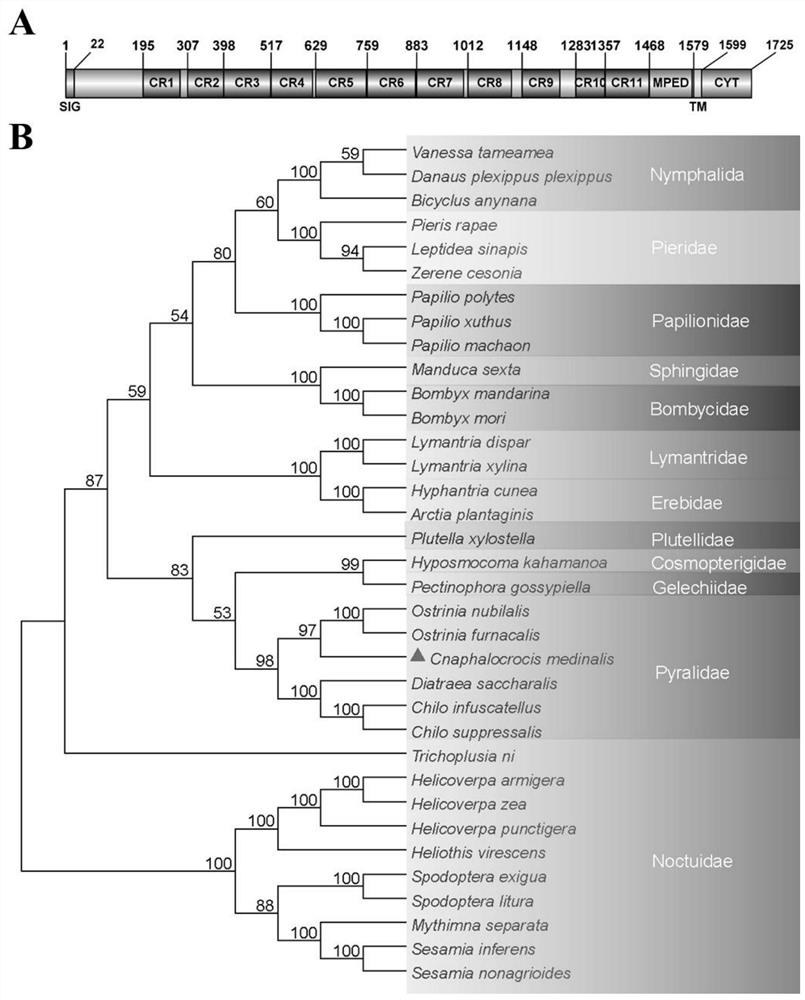Rice leaf roller cadherin Cry toxin binding region coding gene as well as coding protein and application thereof
A technology of rice leaf roller and leaf roller calcium, which is applied in the directions of application, genetic engineering, plant genetic improvement and the like
- Summary
- Abstract
- Description
- Claims
- Application Information
AI Technical Summary
Problems solved by technology
Method used
Image
Examples
Embodiment 1
[0019] Example 1 Amplification of the full-length sequence of the rice leaf roller cadherin gene
[0020] 1.1 Amplification of the conserved region sequence of the rice leaf roller cadherin gene
[0021] Rice leafroller was collected from Nanjing City, Jiangsu Province (118°52'E, 32°01'N). After indoor rearing for several generations, the 4th instar larvae of the same age were selected, RNA was extracted using Invitrogen Trizol kit, and the InvitrogenSuperScript TM II Reverse Transcriptase Kit reverse-transcribes total RNA to obtain cDNA template. The rice leafroller belongs to the Lepidoptera family Pidralidae, and four insects (O.nubilalis, O.furnacalis, D.saccharalis and C.pressalis) of the same family were analyzed using the bioinformatics software DNAMAN version 9.0. cadherin amino acid sequence alignment ( figure 1 ). According to the characteristics of the conserved regions of these four insect cadherins, a pair of degenerate primers (the upstream primer CmCad-con-F...
Embodiment 2
[0031] Example 2 Structure and evolution analysis of CmCad sequence of rice leaf roller cadherin
[0032] The secondary structure features of the rice leaf roller cadherin CmCad were analyzed using the ISRECProfile server (https: / / myhits.isb-sib.ch / cgi-bin / PFSCAN). The phylogenetic tree was constructed by the neighbor-joining method using MEGA 7.0 software, and the numbers at the nodes were the bootstrap values of 1000 repetitions.
[0033] The predicted secondary structure of CmCad, consisting of a signal peptide (SIG), 11 cadherin repeats (CR), membrane-proximal extracellular domain (MPED), transmembrane domain (TMD), and cytoplasmic domain (CYT), is shown to be typical Cadherin structure of insect midgut ( figure 2 A).
[0034] To study the evolutionary relationship of cadherins from different insect species, a phylogenetic tree was constructed using the neighbor-joining method ( figure 2 B), the results show that 3 Nymphalidae, 3 Paleididae, 3 Papilionidae, 2 Silkwo...
Embodiment 3
[0035] Example 3 Construction, expression and purification of the Cry toxin-binding region of the rice leaf roller cadherin
[0036] The TBRs of cadherin Cry toxins in Lepidoptera are mainly located in the six CR domains (eg CR6-11 / CR7-12) and MPED near the cell membrane. Specifically, the CR6-MPED of the rice leaf roller has a total of 817 amino acids, and the truncated CmCad-CR6-MPED fragment was constructed, expressed and purified (J. Zhong, X. Hu, X. Zhang, Y. . Liu, C. Xu, C. Zhang, M. Lin, X. Liu. Broad specificity immunoassay for detection of Bacillusthuringiensis Cry toxins through engineering of a single chain variablefragment with mutagenesis and screening. International Journal of Biological Macromolecules, 2018, 107: 920 -928.). Specifically: use forward primer (CmCad-CR6-MPED-F whose nucleotide sequence is shown in SEQ ID No. 12) and reverse primer (nucleotide sequence as shown in SEQ ID No. 12) containing NcoI and NotI restriction sites respectively. CmCad-CR6-...
PUM
 Login to View More
Login to View More Abstract
Description
Claims
Application Information
 Login to View More
Login to View More - R&D
- Intellectual Property
- Life Sciences
- Materials
- Tech Scout
- Unparalleled Data Quality
- Higher Quality Content
- 60% Fewer Hallucinations
Browse by: Latest US Patents, China's latest patents, Technical Efficacy Thesaurus, Application Domain, Technology Topic, Popular Technical Reports.
© 2025 PatSnap. All rights reserved.Legal|Privacy policy|Modern Slavery Act Transparency Statement|Sitemap|About US| Contact US: help@patsnap.com



